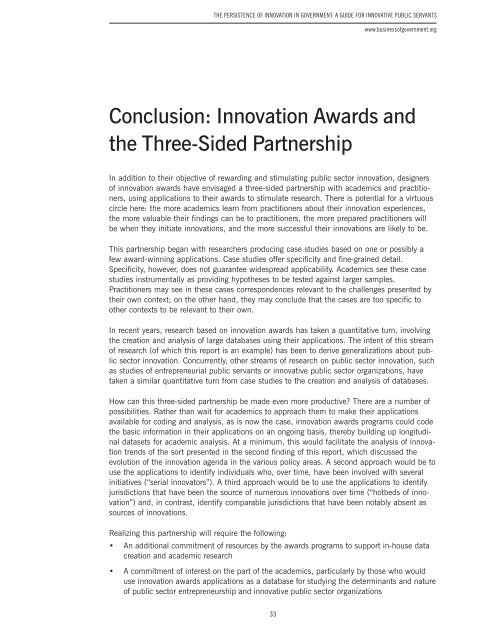The Persistence of Innovation in Government
The Persistence of Innovation in Government
The Persistence of Innovation in Government
- No tags were found...
Create successful ePaper yourself
Turn your PDF publications into a flip-book with our unique Google optimized e-Paper software.
<strong>The</strong> <strong>Persistence</strong> <strong>of</strong> <strong>Innovation</strong> <strong>in</strong> <strong>Government</strong>: A Guide for Innovative Public Servantswww.bus<strong>in</strong>ess<strong>of</strong>government.orgConclusion: <strong>Innovation</strong> Awards andthe Three-Sided PartnershipIn addition to their objective <strong>of</strong> reward<strong>in</strong>g and stimulat<strong>in</strong>g public sector <strong>in</strong>novation, designers<strong>of</strong> <strong>in</strong>novation awards have envisaged a three-sided partnership with academics and practitioners,us<strong>in</strong>g applications to their awards to stimulate research. <strong>The</strong>re is potential for a virtuouscircle here: the more academics learn from practitioners about their <strong>in</strong>novation experiences,the more valuable their f<strong>in</strong>d<strong>in</strong>gs can be to practitioners, the more prepared practitioners willbe when they <strong>in</strong>itiate <strong>in</strong>novations, and the more successful their <strong>in</strong>novations are likely to be.This partnership began with researchers produc<strong>in</strong>g case studies based on one or possibly afew award-w<strong>in</strong>n<strong>in</strong>g applications. Case studies <strong>of</strong>fer specificity and f<strong>in</strong>e-gra<strong>in</strong>ed detail.Specificity, however, does not guarantee widespread applicability. Academics see these casestudies <strong>in</strong>strumentally as provid<strong>in</strong>g hypotheses to be tested aga<strong>in</strong>st larger samples.Practitioners may see <strong>in</strong> these cases correspondences relevant to the challenges presented bytheir own context; on the other hand, they may conclude that the cases are too specific toother contexts to be relevant to their own.In recent years, research based on <strong>in</strong>novation awards has taken a quantitative turn, <strong>in</strong>volv<strong>in</strong>gthe creation and analysis <strong>of</strong> large databases us<strong>in</strong>g their applications. <strong>The</strong> <strong>in</strong>tent <strong>of</strong> this stream<strong>of</strong> research (<strong>of</strong> which this report is an example) has been to derive generalizations about publicsector <strong>in</strong>novation. Concurrently, other streams <strong>of</strong> research on public sector <strong>in</strong>novation, suchas studies <strong>of</strong> entrepreneurial public servants or <strong>in</strong>novative public sector organizations, havetaken a similar quantitative turn from case studies to the creation and analysis <strong>of</strong> databases.How can this three-sided partnership be made even more productive? <strong>The</strong>re are a number <strong>of</strong>possibilities. Rather than wait for academics to approach them to make their applicationsavailable for cod<strong>in</strong>g and analysis, as is now the case, <strong>in</strong>novation awards programs could codethe basic <strong>in</strong>formation <strong>in</strong> their applications on an ongo<strong>in</strong>g basis, thereby build<strong>in</strong>g up longitud<strong>in</strong>aldatasets for academic analysis. At a m<strong>in</strong>imum, this would facilitate the analysis <strong>of</strong> <strong>in</strong>novationtrends <strong>of</strong> the sort presented <strong>in</strong> the second f<strong>in</strong>d<strong>in</strong>g <strong>of</strong> this report, which discussed theevolution <strong>of</strong> the <strong>in</strong>novation agenda <strong>in</strong> the various policy areas. A second approach would be touse the applications to identify <strong>in</strong>dividuals who, over time, have been <strong>in</strong>volved with several<strong>in</strong>itiatives (“serial <strong>in</strong>novators”). A third approach would be to use the applications to identifyjurisdictions that have been the source <strong>of</strong> numerous <strong>in</strong>novations over time (“hotbeds <strong>of</strong> <strong>in</strong>novation”)and, <strong>in</strong> contrast, identify comparable jurisdictions that have been notably absent assources <strong>of</strong> <strong>in</strong>novations.Realiz<strong>in</strong>g this partnership will require the follow<strong>in</strong>g:• An additional commitment <strong>of</strong> resources by the awards programs to support <strong>in</strong>-house datacreation and academic research• A commitment <strong>of</strong> <strong>in</strong>terest on the part <strong>of</strong> the academics, particularly by those who woulduse <strong>in</strong>novation awards applications as a database for study<strong>in</strong>g the determ<strong>in</strong>ants and nature<strong>of</strong> public sector entrepreneurship and <strong>in</strong>novative public sector organizations33


